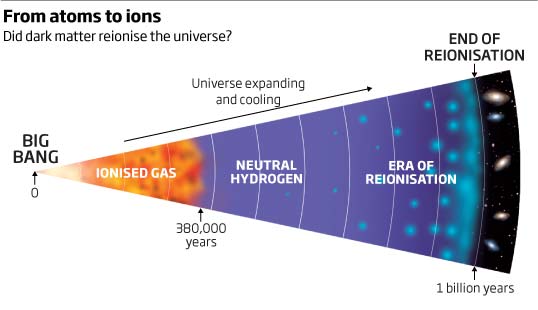
Neutral atoms, mostly of hydrogen, formed about 380,000 years after the big bang, when the universe cooled enough for electrons and nuclei to combine. Most astronomers suspect that the hydrogen was reionised by the first generation of stars (see diagram below). No telescope has ever peered far enough back in time to see the first stars form, but they are thought to have been giants, and their ferocious ultraviolet light could have done the trick.
But Dan Hooper and Alexander Belikov of Fermilab in Batavia, Illinois, think that dark matter - the unseen stuff that makes up about 85 per cent of all matter - could have reionised the universe. Dark matter is thought to be made of massive particles that are predicted to annihilate when they collide, spewing out radiation.
When dark matter clumped together under gravity in the early universe, some of the particles would have annihilated, resulting in high-energy gamma rays. Each gamma ray would have knocked out an electron from a hydrogen atom, which in turn would have dislodged an electron in another atom, and so on. "A single gamma ray might reionise 1000 hydrogen atoms," says Hooper. "The mechanism could easily have reionised the universe."
Using one unsolved mystery to solve another makes some people sceptical. "We have no evidence yet that any dark matter has ever annihilated," says Charles Bennett, of the Goddard Space Flight Center in Greenbelt, Maryland, and principal investigator on NASA's WMAP satellite, which has been studying the reionisation epoch. "I am not saying it is wrong, but it sounds a bit too contrived for me to eagerly accept it."
Hooper says that the European Space Agency's upcoming Planck mission, the successor to WMAP, will study how reionisation proceeded with time. "The time signature of dark matter reionisation will be different from that brought about by stars," says Hooper.




Science fiction